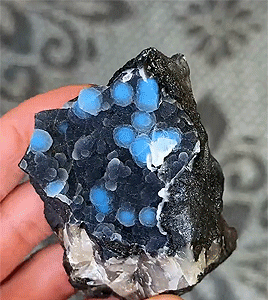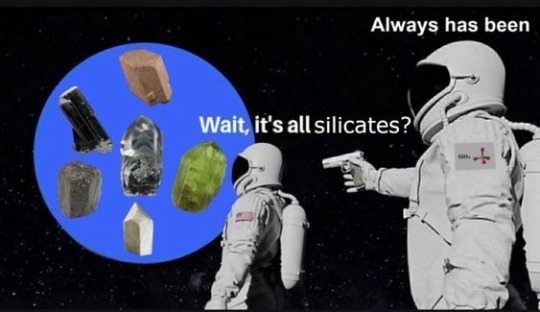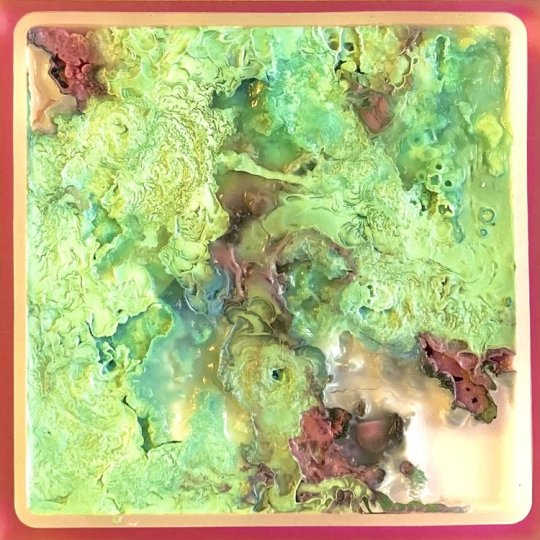#silicate
Explore tagged Tumblr posts
Text

The Silicate Garden
"A chemical reaction creates colorful growths with a remarkably organic appearance (hence the "garden" name). The process is similar to crystallization, but in contrast to ultra-orderly crystals, this is a self-organizing non-equilibrium process that creates complex structures."
35 notes
·
View notes
Text
Happy new year India! :D
May this year bring you more silly and cake
#Silly cake#Silicake#Silicate#I FIGURED UT OUT! WE MUST EAT SILICATE!!#don't try this btw#Silica gel is non toxic but it can block stuff
9 notes
·
View notes
Link
🌏 Get Our Exclusive NordVPN deal here ➼ https://www.nordvpn.com/spacenuts or use the checkout code SPACENUTS. It’s risk-free with Nord’s 30-day money-back guarantee! ✌ In this episode,hosts Andrew Dunkley and Professor Fred Watson delve into the cataclysmic demise of the dinosaurs, exploring various extinction theories with a fervent quest for truth, unraveling the enigmatic ancient puzzle while seeking to unearth the ultimate cause. In this episode, you will be able to: · Explore the fascinating theories behind the extinction of dinosaurs and gain a deeper understanding of this monumental event in Earth's history. · Discover the impact that star growth has on planets orbiting around them, unraveling the intriguing dynamics of celestial bodies. · Delve into the mysteries of the Andromeda galaxy, known for its massive black holes, and uncover the secrets hidden within its immense expanse. · Learn how gravity and Hawking radiation intertwine, shedding light on the intricate relationship between these fundamental forces of the universe. · Immerse yourself in the captivating discussions from the Space Nuts podcast, where space enthusiasts and science lovers engage in thought-provoking conversations about our vast cosmos. · Gain a deeper understanding of the theories surrounding the extinction of dinosaurs and uncover the mysteries behind their disappearance. · Explore the fascinating impact of star growth on orbiting planets, and how it influences the conditions necessary for life to exist. · Discover the captivating secrets of the Andromeda galaxy and its enigmatic black holes, expanding your knowledge of the vastness of the universe. · Unravel the intricate interplay between gravity and Hawking radiation, and its implications for our understanding of the fundamental laws of physics. · Delve into the Space Nuts podcast discussions and indulge your curiosity in a wide array of captivating space-related topics, offering a unique opportunity to expand your knowledge and engage with fellow space enthusiasts. It's extraordinary that 40 years after it was suggested, we're still finding out about this impact and seeing different aspects to it because of the devastation that it caused. - Andrew Dunkley The extinction of dinosaurs has been a topic of intrigue for centuries. Various theories propose the cause to be major environmental changes, catastrophic asteroid impact, or major shifts in vegetation, leading to dental maladies among the dinosaurs. The most recent development in this field proposes a global winter induced by the fallout of an asteroid impact, a theory which aligns with the devastation level required to cause such a mass extinction. The resources mentioned in this episode are: · Visit thecosmosmagazine.com website to read more about the new theory on what caused the extinction of the dinosaurs. · Check out the paper titled Chicxulub Impact Winter, sustained by fine silicate dust in the journal Nature Geoscience for more details on the research. · Explore the concept of the Anthropocene period and human-induced climate change by searching for articles and studies on the topic. · Learn more about the sun and its evolution by researching yellow dwarf stars and stellar evolution. · Discover more about the star Ro Corona Borealis and its similarities and differences to our own sun by searching for information on the star and its characteristics. · Read the paper by Stephen Kane in the Astrophysical Journal to delve deeper into the research on planets orbiting sunlike stars. · In this episode of the Space Nuts podcast, you'll join host Andrew Dunkley as he delves into the fascinating world of space exploration and scientific discoveries. With his friendly and approachable style, Andrew takes you on a journey through various topics, from the theories surrounding the extinction of dinosaurs to the lifecycle of stars and the interplay between galaxies and black holes. He effortlessly combines scientific knowledge with humor and curiosity, making complex concepts accessible to all. Whether you're a space enthusiast or simply curious about the mysteries of the universe, this episode of Space Nuts is sure to captivate your imagination and leave you with a deeper understanding of our cosmic surroundings. So sit back, relax, and get ready to embark on an interstellar adventure with Andrew Dunkley and his guests on Space Nuts. Timestamped summary of this episode: 00:00:00 - Introduction Andrew Dunkley introduces the episode and previews the topics to be discussed, including the extinction of the dinosaurs, planets orbiting a star similar to ours, and audience questions about Andromeda gravity. 00:05:38 - New Theory on Dinosaur Extinction Astronomers in Belgium and the UK have proposed a new theory on the extinction of the dinosaurs. They have found evidence of fine silicate dust in the rock strata, suggesting that the impact of a massive asteroid led to a global winter, which caused the mass extinction event. 00:08:41 - Impact of Silicate Dust The distribution of silicate dust from the asteroid impact was larger than previously estimated. This fine dust, about 1 micron in diameter, could have stayed in the atmosphere for an extended period, contributing to the global winter and the extinction of the dinosaurs. 00:02:16 - Fred's Travels Fred Watson discusses his upcoming travels to Sea Lake in Victoria for an astronomy weekend and his trip to New Zealand for the hundredth anniversary of an astronomical society. He also mentions his participation in a meeting about dark and quiet skies and the impact of satellites on astronomers. 00:04:44 - Interesting Statistics Andrew Dunkley shares interesting statistics, including the percentage of New Zealanders living in Australia (10% of their population) and the fastest-growing nationality moving to Australia (the Nepalese). He humorously advises Fred not to mix up Switzerland with Sweden, referencing a recent 00:17:05 - "Introduction to the Star's Lifecycle" The star in question is a yellow dwarf in its midlife phase, approximately 4.57 billion years old. It is currently in a steady hydrogen burning phase, similar to the Sun. This phase will continue for another 4 billion years before it transitions into a giant star. 00:19:32 - "Planets Orbiting the Star" The star, Ro Corona Borealis, has four known planets orbiting it. These planets are closer to the star than Mercury is to the Sun. One of the planets, Ro Corona Borealis d, is potentially in the habitable zone and could support life. 00:21:35 - "Impact of Star Growth on Planets" As the star grows into a red giant, the planets' fate is uncertain. Some may evaporate or be torn apart by the gravitational effects. Others may be thrown out of the system and become rogue planets. The exact outcomes depend on the planets' orbits and interactions with other planets. 00:25:04 - "Predictions for the Planets" The prediction for the four known planets is that one will evaporate within the star's atmosphere, one will spiral in and be tidally disrupted, one will be destroyed at the end of a phase of evolution, and the fate of the fourth planet is uncertain. There could also be other undetected planets that may survive or be influenced by the star's growth. 00:35:32 - The Spectacular Event of the Andromeda Galaxy The speaker discusses the possibility of the Andromeda galaxy getting closer to our galaxy. Although the event would be spectacular, it would happen on a timescale that wouldn't affect us humans. 00:36:27 - Collision of Galaxies The collision between our galaxy and the Andromeda galaxy would result in a phenomenal sight, but it would be a slow process that wouldn't impact us directly. Simulations indicate that the two galaxies will pass through each other multiple times before settling into a new galaxy devoid of hydrogen. 00:37:33 - Black Hole Merger In response to a listener's question, it is mentioned that the black holes in the Milky Way and Andromeda galaxies would eventually merge due to their relative gravitational forces. This merging process is expected to happen during the collision of the two galaxies. 00:38:59 - Can Gravity Escape a Black Hole? The question of whether gravity can escape a black hole is explored. Gravity is a force field associated with a theoretical particle called a graviton, but it has never been observed or confirmed. The escape of gravitons from a black hole remains uncertain. 00:41:23 - The Myth of Bagpipes on the Moon The story of a mechanic named William Rudd playing bagpipes at the Tidbin Biller station during the Apollo program is shared. While it is unclear if the sound of the bagpipes was actually heard on the moon, The extinction of dinosaurs has been a topic of intrigue for centuries. Various theories propose the cause to be major environmental changes, catastrophic asteroid impact, or major shifts in vegetation, leading to dental maladies am
#asteroid#changes#chicxulub#cretaceous-paleogene#dental#dinosaur#dinosaurs#dust#environmental#extinction#fine#impact#of#plaque#problems#silicate#theories#tsunamis#winter
8 notes
·
View notes
Text
If your name is Katherine it Kate or anything similar and you have a background in geology, please consider creating an educational/public science communicator persona called Silly Kate.
Take it for free, I just want to see it exist
3 notes
·
View notes
Text
Singly and in combination (as 'silicates'), these four earths make up just about two thirds of the earth's crust.
"The Stars in their Courses" - Isaac Asimov
#book quote#the stars in their courses#isaac asimov#nonfiction#essay#the multiplying elements#silica#alumina#lime#magnesia#silicon dioxide#aluminum oxide#calcium oxide#magnesium oxide#silicate#earth
1 note
·
View note
Text
silicate

1 note
·
View note
Photo

In English language, Pneumonoultramicroscopicsilicovolcanoconiosis (45 letters) is officially the longest word that is a technical term referring to a lung disease caused by the inhalation of very fine silicate or quartz dust.
(via Can YOU pronounce them? The 10 longest words in the English dictionary revealed)
#english#linguistics#oxford dictionary#dictionary#words#terms#medicine#lungs#silicate#quartz#silicosis#lexicon
1 note
·
View note
Text


💎 shiny rocks make brain go brrrr ✦ shattuckite [x]
#crystals#minerals#shattuckite#blue#another new one to me! it's a copper silicate. just lovely. uwu#the name comes from the mine where it was discovered!#forbidden blueberries#✦ gifs
494 notes
·
View notes
Text

101 notes
·
View notes
Text


Indelicate Grass by Lyndsay Hogland.
"Indelicate Grass was created by “painting” with specific metal salts, suspending them in a sodium silicate solution, and then preserving the results in resin."
31 notes
·
View notes
Text










Yellowstone National Park, WY (No. 23)
Yellowstone is at the northeastern end of the Snake River Plain, a great bow-shaped arc through the mountains that extends roughly 400 miles (640 km) from the park to the Idaho-Oregon border.
The volcanism of Yellowstone is believed to be linked to the somewhat older volcanism of the Snake River Plain. Yellowstone is thus the active part of a hotspot that has moved northeast over time. The origin of this hotspot volcanism is disputed. One theory holds that a mantle plume has caused the Yellowstone hotspot to migrate northeast, while another theory explains migrating hotspot volcanism as the result of the fragmentation and dynamics of the subducted Farallon Plate in Earth's interior.
The Yellowstone Caldera is the largest volcanic system in North America, and worldwide it is only rivaled by the Lake Toba Caldera on Sumatra. It has been termed a "supervolcano" because the caldera was formed by exceptionally large explosive eruptions. The magma chamber that lies under Yellowstone is estimated to be a single connected chamber, about 37 miles (60 km) long, 18 miles (29 km) wide, and 3 to 7 miles (4.8 to 11.3 km) deep. The current caldera was created by a cataclysmic eruption that occurred 640,000 years ago, which released more than 240 cu mi (1,000 km3) of ash, rock and pyroclastic materials.This eruption was more than 1,000 times larger than the 1980 eruption of Mount St. Helens. It produced a caldera nearly 5⁄8 mi (1.0 km) deep and 45 by 28 miles (72 by 45 km) in area and deposited the Lava Creek Tuff, a welded tuff geologic formation. The most violent known eruption, which occurred 2.1 million years ago, ejected 588 cu mi (2,450 km3) of volcanic material and created the rock formation known as the Huckleberry Ridge Tuff and the Island Park Caldera. A smaller eruption ejected 67 cu mi (280 km3) of material 1.3 million years ago, forming the Henry's Fork Caldera and depositing the Mesa Falls Tuff.
Source: Wikipedia
#Black Opal Pool#Midway Geyser Basin#Sapphire Pool#Yellowstone National Park#fauna#flora#travel#original photography#vacation#tourist attraction#landmark#landscape#countryside#subalpine forest#USA#summer 2024#Wyoming#UNESCO World Heritage Site#geothermal feature#geology#Yellowstone Plateau#Rocky Mountains#siliceous sinter#geyserite#Teton County#Upper Geyser Basin#Biscuit Basin Trail#Silver Globe Geyser Complex#Wall Pool#Firehole River
16 notes
·
View notes
Text
Table 1.1 lists some important physical features of our present-day Earth.

"Environmental Chemistry: A Global Perspective", 4e - Gary W. VanLoon & Stephen J. Duffy
#book quotes#environmental chemistry#nonfiction#textbook#physical features#earth#mass#radius#density#sun#planet earth#temperature#atmosphere#ocean#land#nitrogen#oxygen#water#argon#sodium#chlorine#sulfate#magnesium#aluminum#iron#calcium#silicate#oxide#carbonate
0 notes
Text

Why choose between who to ship who with when you can just make them all a polycule
#do they have a name#I don't think zane exactly knows his sexuality but if asked he'd say bi bc it's what makes the most logical sense#if they don't ld like to propose amethystshipping#bc... purple rock... that produces electricity when pressure is applied#and silicates like quartz are used in microchips#also you should read the fanfiction my friend meavaly made that's mildly related to this on AO3 called we just laugh#ninjago#zane ninjago#zane julien#pixal ninjago#pixal borg#ninjago pixal#pixane#cole bucket#cole hence#cole brookstone#cole ninjago#glacier ninjago#glaciershipping#geo ninjago#geode ninjago#geodeshipping#lostshipping#lostshipping ninjago
49 notes
·
View notes
Text

Felt like giving her something casual
18 notes
·
View notes
Text
trouble differentiating sulfite and sulfate? got a problem with halogenides? just rely on your DEAR OLD FRIEND KALIUMPERMANGANAT, THE ONE WHO DOES IT ALL!!!
No reducing substances in my sauce no sir no sir we got sulfate in this house 🫡
#feli speaks#uni posting#choosing to believe i only have 3 anions bcuz i dont want to fucking do silicate#and also someone just. stole?? my borat proof?? SOMEONE JUST STOLE MY BORATE PROOF??? WHERE IS MY PORCELAIN BOWL. WHERE IS IT.
7 notes
·
View notes
